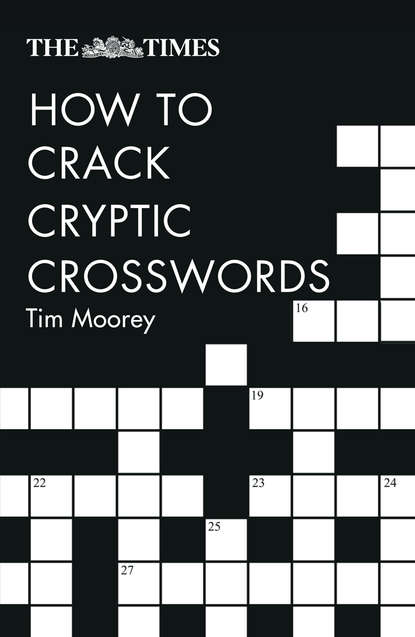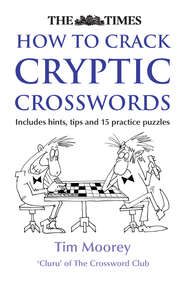По всем вопросам обращайтесь на: info@litportal.ru
(©) 2003-2024.
✖
The Times How to Crack Cryptic Crosswords
Настройки чтения
Размер шрифта
Высота строк
Поля
2: Overview of Clues and Indicators (#ulink_a2a538cf-412f-573f-a4e4-ed1c0b8f29a5)
“The question is,” said Alice, “whether you can make words mean so many different things.”
Lewis Carroll, Through the Looking Glass
In this chapter I provide a short overview of the basics of clues and how to recognize them. Detailed points on each clue type are the subject of Chapter 3 (#ulink_41cff510-65bc-51b1-bfb4-b1d3290e9909).
Characteristics of a cryptic clue
We will consider twelve types of cryptic clue, of which the majority conform to the principles contained in this image:
Cryptic clues (mostly) have two parts
Either the definition or the wordplay can come first in the clue sentence; and either could be exploited first to obtain the solution. Whichever does come second in your solving order acts as confirmation that you have the correct solution.
Taking each element in turn:
Definition: The definition can
take the form of a word, or words in a phrase
be an example of the solution (e.g. fruit can be defined as apple, perhaps)
be a (misleadingly expressed) synonym of the solution. To this end, definitions are often words that have more than one meaning
Wordplay: This is the way to elicit the solution if the definition does not do so. It can be seen as either:
the letters of the solution needing manipulation in one of several ways to provide another indication of the definition, or
individual word or words in the clue having to be interpreted in a different way from the surface meaning
Perhaps strictly accurately the terms should be word and letterplay (though not, as an elderly student once stumbled over, “loveplay”!).
TOP TIP – DEFINITION PLACEMENT
Beginners find it much easier to decode a cryptic clue when they are told that the definition is almost always either at the beginning or end of the clue sentence or phrase.
Solution: This can be one or more words whose word-length is shown at the end of the clue in parentheses (the enumeration).
An example of how this works is seen in this clue which has a simple juxtaposition of three parts from which the solver has to discover which parts are which before progress can be made. Here it could be that either find or above is the definition. In fact it is find.
Find record above (8)
Linkwords: Few clues are as straightforward in construction as the previous example and the first mild challenge is that there is often a linkword between the two parts to give the solution. The chart then is:
CRYPTIC CLUES WITH LINKING WORDS
Below is a clue which also starts with the definition but, in addition, has a linkword, one that is commonly used: from. The sense conveyed by from is that a synonym for church house can be formed from the two parts earlier and years (if the latter is taken as an abbreviation – more on this later).
Church house from earlier years (6)
Next is an example in which the definition is the final word in the clue and in which the linkword is in, the sense being that the wordplay is seen in the solution.
ADDITIVE CLUE: Keep wine in northern town (9)
As well as linkwords between definition and wordplay, there can also be similar linkage within the wordplay to connect its different parts. Here it is and, a simple additive indication. The other linkword is indicates that the definition can be formed from the wordplay.
ADDITIVE CLUE: What babies need is sleep and food (7)
You will notice that the last two of the example clues are labelled additive. In fact all so far have been of this type, a relatively plain construction of A + B = C which we shall consider later in more detail as one of the twelve clue types, dividing these into one group of eight and one group of four. Why split clues into two groups? Because some always contain the means of identifying their type (the first eight) and others virtually always do not (the remaining four). This distinction is amplified in the section which follows.
Indicators
At this point, beginners tend to say:
“Yes, I know that there are different types of clue but how on earth do I know which is which?”
The answer is as follows. For the first group of eight there is always a signpost to the solution, called the indicator, within the clue sentence. Remember, an indicator is the means of identifying clue types. In Chapter 3 (#ulink_41cff510-65bc-51b1-bfb4-b1d3290e9909) we will consider the specific indicators for the first group of eight clue types. In the example the indicator is wrong, showing that this is an anagram clue. The concept behind this indicator is that the letters to be mixed are incorrect and must be changed to form the solution. There are many ways of giving the same anagram instruction to solvers, as you will also see in Chapter 3 (#ulink_41cff510-65bc-51b1-bfb4-b1d3290e9909).
ANAGRAM CLUE: President saw nothing wrong (10)
For the remaining group of four, it’s usually a case of informed guesswork rather than indicators. This may seem unreasonable and impossible for the novice solver but I aim to prove that this is not really the case.
In the meantime, this may be a good time to point out that trial and error and/or inspired guesswork are part and parcel of good solving. This is reinforced by the clueing practice of all good setters whereby the clue type will nearly always become clear on working backwards from the solutions. Indeed, when a solver sees the solution the following day, he or she should only rarely be left thinking (as Ximenes put it):
“I thought of that but I couldn’t see how it could be right.”
We will now proceed to examine in detail all clue types and their indicators, with one and sometimes two examples of each type.
3: Clue Types and Indicators in Detail (#ulink_32215948-ea21-5e12-bbbf-418a1b7dc5d9)
“Give us a kind of clue.” W.S. Gilbert, Utopia Limited
Until Chapter 8 (#litres_trial_promo), we’ll keep it simple with regard to clue types. In later chapters we will see that the clue types can and often do overlap, involving more than one sort of manipulation of letters or words within any one clue.
The first eight clue types
We will now examine each of the eight clue types in detail, together with their indicators, and offer some example clues. To give yourself solving practice, you may wish from now on to cover up the bottom part of the diagram that contains the solution and wordplay.
The first eight types are shown in the circular chart below, and we shall take each in turn, working clockwise from the top.
1. The anagram clue
An anagram, sometimes termed a letter mix, is a rearrangement of letters or words within the clue sentence to form the solution word or words.
The letters to be mixed (the anagram fodder) may or may not include an abbreviation, a routine trick for old hands but, as I have observed, a cause of some discomfort for first-timers.
ANAGRAM CLUE: Mum, listen for a change (6)






